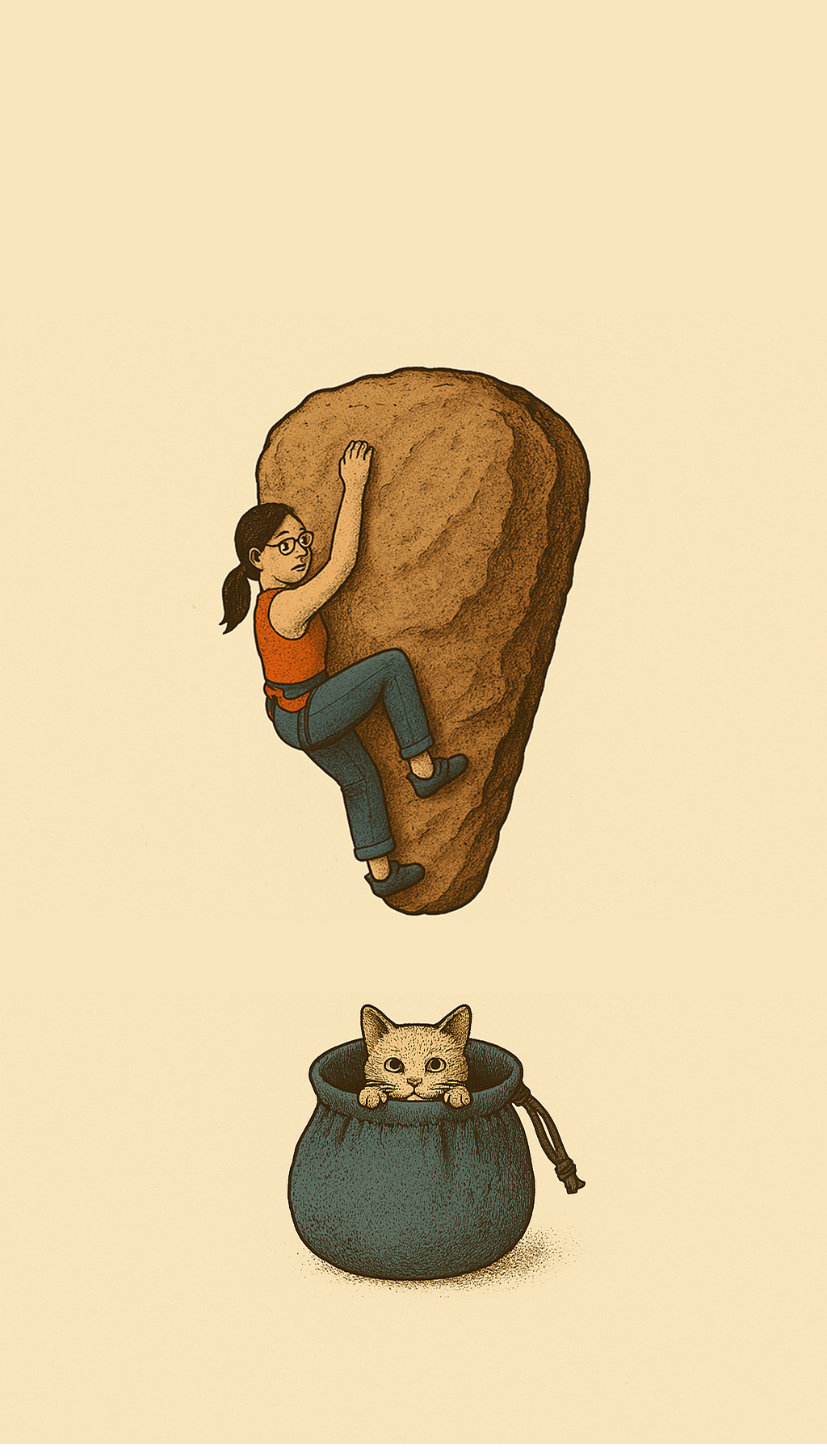Unlearning the Jug Bias: A Micro-Practice for Rewiring Your Climbing Instincts
Reclaiming Comfort, Curiosity, and Control with “Bad Holds”
Climbing, even in its most recreational forms, activates our survival instincts.
Whether you’re just inches off the ground on a boulder problem—surrounded by perfectly placed pads and attentive spotters—or confidently tied into your harness on a closely-read sport route, the moment your feet leave the ground, something shifts. That shift isn’t just physical; it’s neurological. We subconsciously assign value to features that promise safety. Big jugs, incut footholds, and deep sidepulls become the gold standard. They represent security. Control. Escape from falling.
This response is completely understandable. It’s coded into our biology. The instinct to avoid falling is powerful, ancient, and in many ways, useful. But left unchecked, it creates a subtle distortion in how we relate to climbing.
The Hidden Cost of Survival-Driven Climbing
When our brains become wired to prioritize “good” holds and fear “bad” ones, a few things happen:
We unconsciously shape our definition of climbing as “starting off the ground and getting to the top without falling.”
Falling becomes failure.
“Hard-to-use” holds become the enemy, rather than a source of discovery.
Our curiosity, creativity, and attention get drowned out by efficiency and control.
Over time, this value system can erode both progress and joy. What if we gently questioned it? What if, instead of constantly trying to avoid bad holds, we learned to befriend them?
Redefining Value: A Micro-Practice for Curious Contact
This 2–5 minute practice invites you to temporarily step outside the mainstream climbing narrative. There is no wall angle to resist, no flash pump, no stakes—just you, your balance, and one small feature.
What You’ll Need:
Any textured, solid surface: a wall, pillar, concrete ledge, tree trunk, building façade.
A “bad hold”: something small, subtle, or sharp. A 1mm mono. A tiny sloping nub. A micro edge you’d normally scoff at.
How to Practice:
Approach with Soft Eyes and Firm Feet
Stand close to the surface, weight evenly over both feet. Choose a front-on or side-on position that allows full hip mobility. Let your stance feel grounded and quiet.Select Your “Bad” Hold
Find the smallest possible feature that wouldn’t be useful in an actual climb—yet still provides some tactile feedback. Maybe a thumbdercling-sized crack or a pinky-width ripple.Initiate Contact
Gently place one finger or thumb on the feature. Apply light but intentional pressure—not to pull or crank, but to explore. This isn’t a grip test. It’s a communication.Move From the Hips
Keeping your feet static, begin to shift and sway through your hips. Let your torso and shoulders respond to the changing relationship between your body and the hold. Think: side lunges, gentle rotations, micro-leaning.Keep Your Eyes on the Hold
Throughout, maintain soft visual contact with the feature. Let it drift in your field of view as you move, but stay tethered to it visually. Let your gaze mirror the steadiness you’re building in your finger.Added Challenge:
Perform the “drawing with the hips drill” in this new setting.
What This Rewires
Perception: Over time, your brain stops categorizing holds as "good" or "bad" based on outcome-driven value.
Motor Control: You develop micro-level control in your fingers and hands, refined through calm, conscious effort—not panic or force.
Balance: The interplay of fixed feet, moving hips, and a subtle hand anchor builds exceptional awareness of your center of mass.
Emotional Regulation: Practicing presence with discomfort, in a safe context, trains your nervous system to stay calm in high-stakes situations.
Redefining the Narrative
There’s nothing inherently wrong with climbing “to the top.” That goal gives shape to our sessions and stories. But we don’t have to always climb in service of ascent. This practice helps you remember: climbing is not just vertical progress—it’s a conversation with texture, tension, and attention.
So the next time you walk past a brick wall, a tree knot, or a crumbling garden ledge, pause. Press a finger to the smallest protrusion you can find. Let your hips shift. Let your gaze linger. Let a “bad” hold hold you—if only for a moment.
You might just find beauty where your survival brain saw none.
